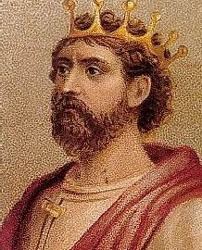Predecessor AEthelstan Siblings AEthelstan, Eadred Name Edmund I | Burial Glastonbury Abbey Successor Eadred | |
 | ||
Tenure 27 October 939 – 26 May 946 Coronation c.29 November 939
probably at Kingston upon Thames Died 26 May 946
Pucklechurch, Gloucestershire, England Assassinated May 26, 946 AD, Pucklechurch, United Kingdom Parents Eadgifu of Kent, Edward the Elder Children Edgar the Peaceful, Eadwig Spouse AEthelflaed of Damerham (m. 944 AD), AElfgifu of Shaftesbury (m. ?–944 AD) Similar People Edward the Elder, Edgar the Peaceful, Eadred, Eadwig, AEthelstan | ||
Edmund Ironside: The Last Warrior King of Wessex
Edmund I (Old English: Ēadmund, pronounced [æːɑdmund]; 921 – 26 May 946), called the Elder, the Deed-doer, the Just, or the Magnificent, was King of the English from 939 until his death. He was a son of Edward the Elder and half-brother of Æthelstan. Æthelstan died on 27 October 939, and Edmund succeeded him as king.
Contents
- Edmund Ironside The Last Warrior King of Wessex
- Early life and military threats
- Louis IV of France
- Death and succession
- References
Early life and military threats
Edmund came to the throne as the son of Edward the Elder, and therefore the grandson of Alfred the Great, great-grandson of Æthelwulf of Wessex and great-great grandson of Egbert of Wessex, who was the first of the house of Wessex to start dominating the Anglo Saxon realms. However, being born when his father was already a middle aged man, Edward lost his father when he was a toddler, in 924, which saw his 30 year old half brother Athelstan come to the throne. Edmund would grow up in the reign of Athelstan, even participating in the Battle of Brunanburgh in his adolescence in 937
Athelstan died in the year 939, which saw young Edmund come to the throne. Shortly after his proclamation as king, he had to face several military threats. King Olaf III Guthfrithson conquered Northumbria and invaded the Midlands; when Olaf died in 942, Edmund reconquered the Midlands. In 943, Edmund became the god-father of King Olaf of York. In 944, Edmund was successful in reconquering Northumbria. In the same year, his ally Olaf of York lost his throne and left for Dublin in Ireland. Olaf became the king of Dublin as Amlaíb Cuarán and continued to be allied to his god-father. In 945, Edmund conquered Strathclyde but ceded the territory to King Malcolm I of Scotland in exchange for a treaty of mutual military support. Edmund thus established a policy of safe borders and peaceful relationships with Scotland. During his reign, the revival of monasteries in England began.
Louis IV of France
One of Edmund's last political movements of which there is some knowledge is his role in the restoration of Louis IV of France to the throne. Louis, son of Charles the Simple and Edmund's half-sister Eadgifu, had resided at the West-Saxon court for some time until 936, when he returned to be crowned King of France. In the summer of 945, he was captured by the Norsemen of Rouen and subsequently released to Duke Hugh the Great, who held him in custody. The chronicler Richerus claims that Eadgifu wrote letters both to Edmund and to Otto I, Holy Roman Emperor in which she requested support for her son. Edmund responded to her plea by sending angry threats to Hugh. Flodoard's Annales, one of Richerus' sources, report:
Edmund, king of the English, sent messengers to Duke Hugh about the restoration of King Louis, and the duke accordingly made a public agreement with his nephews and other leading men of his kingdom. [...] Hugh, duke of the Franks, allying himself with Hugh the Black, son of Richard, and the other leading men of the kingdom, restored to the kingdom King Louis.
Death and succession
On 26 May 946, Edmund was murdered by Leofa, an exiled thief, while attending St Augustine's Day mass in Pucklechurch (South Gloucestershire). John of Worcester and William of Malmesbury add some lively detail by suggesting that Edmund had been feasting with his nobles, when he spotted Leofa in the crowd. He attacked the intruder in person, but in the event, Leofa killed him. Leofa was killed on the spot by those present. A recent article re-examines Edmund's death and dismisses the later chronicle accounts as fiction. It suggests the king was the victim of a political assassination.
Edmund's sister Eadgyth, the wife of Otto I, Holy Roman Emperor, died earlier the same year, as Flodoard's Annales for 946 report.
Edmund was succeeded as king by his brother Eadred, king from 946 until 955. Edmund's sons later ruled England as:
